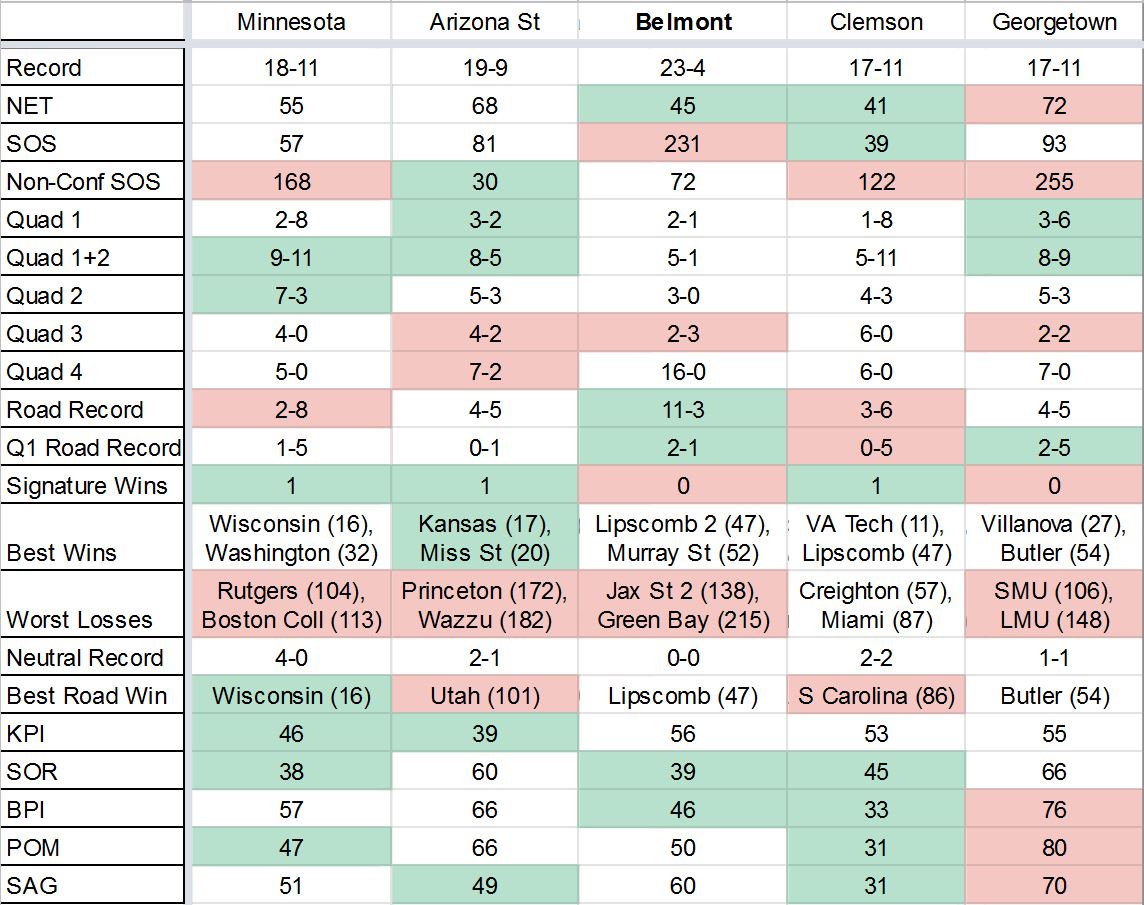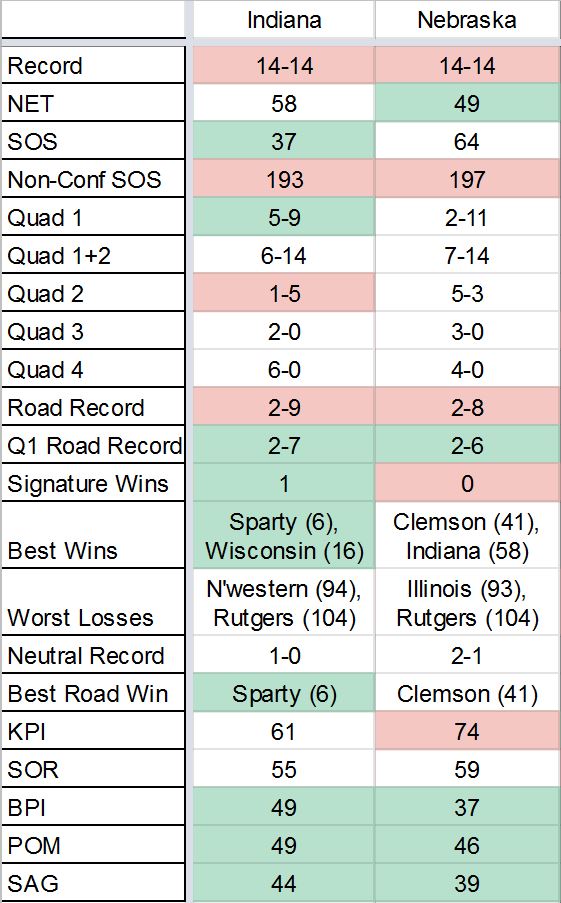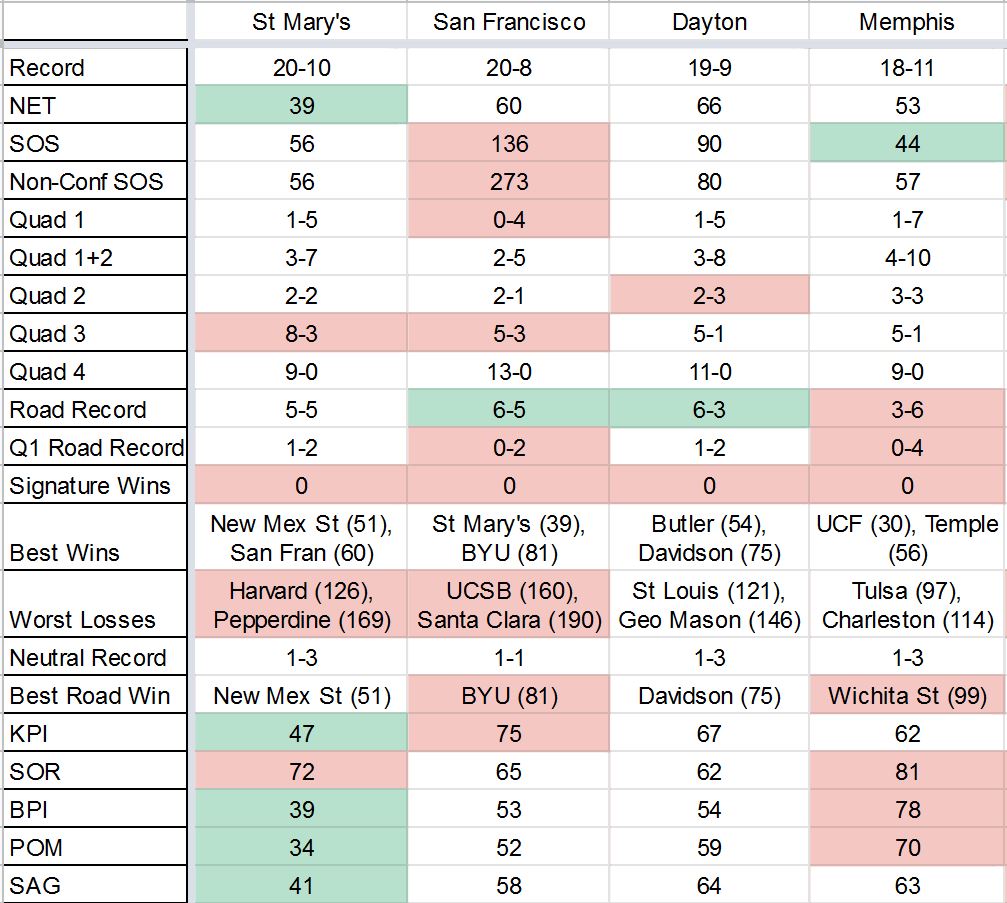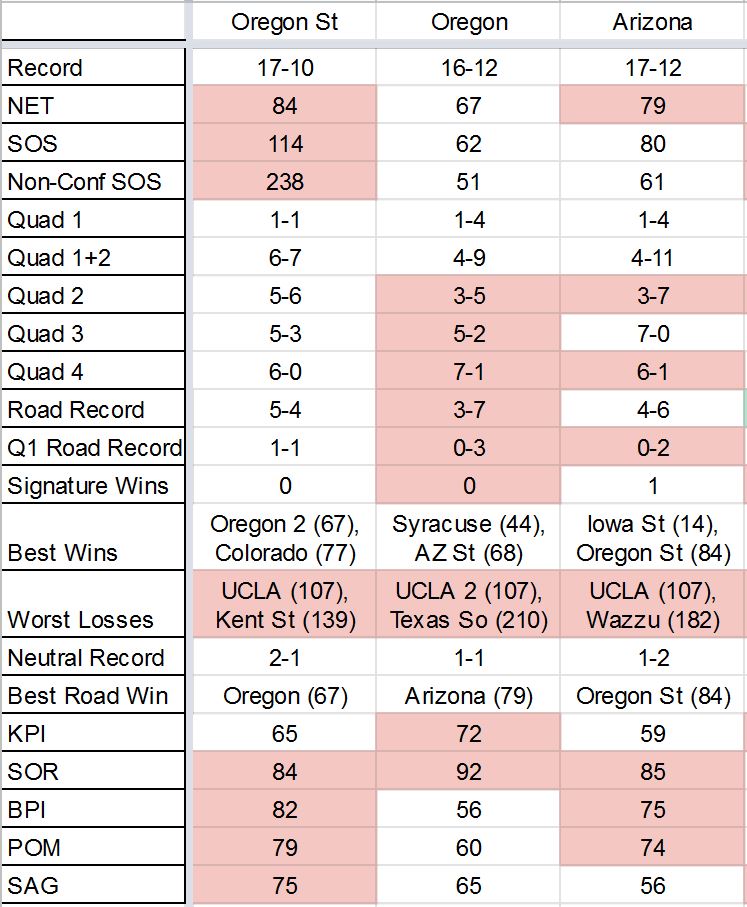Welcome to March! It’s hard to believe the college basketball season has gone by so fast and we are nearing the end of the regular season and Selection Sunday. The first conference tournaments will begin on March 5 and the Selection Committee will name the Field of 68 on March 17. I have been updating my bracket projections twice a week during the month of February. Now as we get closer to Selection Sunday, the frequency of bracketology updates will increase, so keep your eyes on the SCB Bracketology Page. I will once again be competing in The Bracket Project’s bracketology challenge (where I rank ahead of ESPN’s Joe Lunardi and CBS Sports’ Jerry Palm). Here is a breakdown of how I see the bracket heading into March.
As a reminder on structure, the NCAA’s Team Sheets are broken down into “quadrants” that have a team’s games organized by their opponents NET ranking. Quadrant 1 is home games against teams ranked 1-30, neutral games against teams ranked 1-50, and road games against teams ranked 1-75. Quadrant 2 is home games against teams ranked 31-75, neutral games against teams ranked 51-100 and road games against teams ranked 76-135. Quadrant 3 is home games against teams ranked 76-160, neutral games against teams ranked 101-200, and road games against teams ranked 130-240. Quadrant 4 covers games against the rest of the 353 Division 1 schools. For ease of terminology, I am calling wins over teams ranked in the top half of Quadrant 1 “signature wins.”
1 Seeds
On February 9th the Committee revealed their Top 16 teams at that point in time. Duke, Virginia, Tennessee, and Gonzaga were the 1-seeds a month ago. Since then, Duke has dropped 2 games with the injury to Player of the Year candidate Zion Williamson but also has a win over Virginia. Virginia’s only losses this season came against Duke, so they should be slotted behind the Blue Devils but only one spot. With Duke falling to 4 losses, their case as the #1 overall seed took a slight hit. Gonzaga is currently the only team to have defeated a fully healthy Duke squad, and the Zags only losses came against Tennessee and North Carolina. This elevates Gonzaga to the #1 overall seed. For the last spot on the 1-seed line, Kentucky’s double-digit win over Tennessee a few weeks ago made a statement. Furthermore, the Wildcats have more Quad 1 victories (9 to 7) than the Vols. Kentucky also has a head-to-head win over North Carolina on a neutral court.
2 Seeds
North Carolina’s win over Duke elevated the Tar Heels to the top of the 2-seed line. UNC’s 6 wins against teams in the top half of Quad 1 are tied for the most of any remaining team and they have no losses outside of Quad 1. Michigan State’s 7 road wins against Quad 1 are the most of any remaining team, as are their 10 Quad 1 victories. Tennessee stays right in the thick of the 2-seed line after their losses to Kentucky and LSU but still have no bad losses. The last spot came down to two Big Ten teams. I gave Michigan the edge over Purdue based on a 19-point head-to-head victory and having no losses outside of Quad 1.
3 seeds
On my bracket, there has been minimal change on the 3-seed line since the Committee’s reveal on February 9th. Purdue’s 5 road wins against Quad 1 are the most of any remaining team. Similarly, Kansas’ 10 Quad 1 victories are the most of any remaining team. The Committee initially had Houston as the 11th-overall team and the Cougars have not lost since then. Despite a gaudy NET ranking of 4, with just 3 Quad 1 victories I could not find a good case to move Houston ahead of Kansas or Purdue. I debated between LSU and Marquette for the last spot on the 3-seed line. Ultimately, LSU more road wins, more Quad 1 road wins, and more “signature” wins with 2 wins better than Marquette’s best win.
4 seeds
Marquette still has an impressive resume with 8 Quad 1 victories and only 1 loss outside of Quad 1. Wisconsin is close behind with 8 Quad 1 victories but their two Quad 2 losses are in the bottom half of that quadrant. Texas Tech has no losses outside of the top half of Quad 1. The Red Raiders have 5 Quad 1 victories and solid computer numbers. Nevada was a surprise appearance in the Committee’s February 9th bracket reveal on the 4-seed line. The Wolfpack’s resume is largely the same today as it was three weeks ago with no games in Quad 1 but 8 Quad 2 wins. They did drop a Quad 2 game at San Diego State, just their second setback of the year. Nevada is a good team but it is hard to gauge where they will land with no Quad 1 opponents on the slate. For now, I kept them as the last #4 seed.
5 seeds
Virginia Tech’s home victory over Duke gave them a third “signature” win against the top half of Quad 1. With Penn State’s rise into the Top 50, the Hokies don’t have a loss outside of Quad 1. Maryland has 6 Quad 1 victories with 4 coming on the road, tied for the most among remaining teams. Kansas State is tied for the Big XII lead with Texas Tech, holding a slight edge over in-state rival Kansas. The Wildcats have 4 wins against the top half of Quad 1 which is tied for the most among remaining teams. Iowa State has an impressive 4 road victories against Quad 1 teams, tied for the most of any remaining team. The final spot on this line came down to Iowa State and Mississippi State. Ultimately, I gave it to the Cyclones based on their top-end wins (3 to 1 in “signature wins”).
6 seeds
Mississippi State’s 9 Quad 1 wins are the most of any team remaining. However, only 1 of those wins came against the top half of Quad 1 and they have a sub-.500 record (2-3) against Quad 2. Villanova stopped a mini-slide in a big way with a 6-point win over Big East leader Marquette this week. The Defending Champs also have a 6-point head-to-head win over Florida State. Florida State dropped two strange road games in mid-January to Boston College and Pitt, but has been very consistent since then. The Seminoles 6 Quad 1 wins are more than any team beneath them. Iowa has been one of the most fun teams in the nation to watch as sharpshooter Jordan Bohannon has a knack for the dramatic and has hit clutch 3 after clutch 3 this season. The Hawkeyes haven’t lost a game outside of Quad 1.
7 seeds
Louisville ranked 15th in the Committee’s initial bracket reveal, but the Cardinals have tumbled since then. They have lost 5 of their last 6, including blowing a 23-point lead against Duke. With the exception of their loss to Boston College, Louisville’s losses have all been to Quad 1 teams, so it has not severely hurt their resume but the Cardinals have slid down the bracket. Baylor has rebounded from early-season Quad 4 losses to Texas Southern and Stephen F Austin to put together a resume worthy of an at-large bid. The Bears swept Iowa State and have 3 wins against the top half of Quad 1. Ole Miss does not have a loss outside of the Top 100 and has 2 wins against the top half of Quad 1, which keeps them ahead of Cincinnati. Cincinnati is a hard team to gauge because of their 1 terrible loss to East Carolina. How much will that hurt the Bearcats seeding? They have been a strong contender in the AAC this season and have 4 Quad 1 wins.
8 seeds
Buffalo is the favorites in the MAC and should earn an at-large bid if they don’t win their conference tournament. The Bulls have road losses to Marquette, Bowling Green, and Northern Illinois. Overall, their metrics are good and both of their Quad 1 wins came on the road. Wofford is an interesting case and could make the SoCon a 2-bid league if they fall in their conference tournament. The Terriers have 3 Quad 1 wins and no bad losses. The one drawback to their resume is thei quality of their schedule, where over half of their wins came in Quad 4. All four of Ohio State’s Quad 1 victories have come on the road. None of the teams currently have more than 3 road wins in Quad 1. Florida has been a rapid riser of late, scoring their best two victories over the last two weeks. The Gators added Quad 1 road wins over LSU and Alabama to offset their large quantity of losses. The Gators have a chance to rise even higher with games against Kentucky and LSU still to come in March.
9 seeds
One of the biggest discrepancies between metrics and resumes is Auburn who is 2-7 against Quad 1 with 2 additional Quad 2 losses but ranks in the Top 25 in NET, BPI, KenPom, and Sagarin. Auburn has yet to beat a team in the top half of Quad 1 and their lack of signature wins and road wins should drop the Tigers into the middle of the pack. Oklahoma lacks a true signature win, but their 3 Quad 1 victories and no bad losses should be enough to keep the Sooners on the right side of the bubble. Washington is running away with the Pac-12 but just took their worst loss of the season, falling at California. On paper the Huskies look very similar to a top mid-major school with just 1 Quad 1 victory. St. John’s is a difficult team to gauge. The Red Storm have 6 Quad 1 wins, but only 1 against the top half and are just 4-3 against Quad 2 and 2-2 against Quad 3.
10 seeds
Syracuse’s 3 Quad 1 victories, 2 of which came on the road, solidifies their spot. One of those was at Duke and the other at Ohio State. NC State is one of the most polarizing teams this season. The Wolfpack have certainly benefitted tremendously from the move from RPI to NET. Under the RPI NC State would be 88th but they are 31st in the NET rankings. The Wolfpack have only one bad loss but lack a signature win to seal their status in the Tournament. VCU might be the only A-10 team capable of earning an at-large bid if they fail to win the conference tournament. The Rams have 2 Quad 1 wins to offset their 2 Quad 3 losses. They played one of the hardest non-conference schedules in the nation, which should keep them safe as long as they don’t collapse in early March. Temple has just 1 Quad 1 victory, but it is a high-quality victory over Houston. Beyond that, the Owls have just 2 losses outside of Quad 1 and should be the third AAC team in the Tournament.
THE BUBBLE
11 seeds
Stop me if you’ve heard this before, but a Jamie Dixon team is fighting for their lives on the bubble. TCU has 3 Quad 1 wins, including a sweep of Iowa State that might be enough to get them in. Their 4-4 record against Quad 2 is a bit concerning, as is their 2-7 road record. In the midst of a crowded Big East pack, Seton Hall has distinguished themselves with 4 Quad 1 wins including one over Kentucky and road wins at Maryland and Creighton. Those wins should be enough to get them in, but 2 Quad 3 losses to raise a red flag and are a cause for concern. Texas has the top-end victories (3 against the top half of Quad 1) to put them in contention for a much better seed. However, the Longhorns are also just 2 games over .500 and are 2-7 on the road. Adding to that, Texas has multiple Quad 3 losses. Despite a good NET ranking and Top-30 rankings in BPI, KenPom, and Sagarin, Texas may find themselves further down the bracket than one would expect. Alabama’s wins over Kentucky and Mississippi State are keeping the Crimson Tide on the right side of the bubble for now. They have questionable losses to Northeastern and Georgia State in non-conference play and no Quad 1 road wins.
Last 4 In
Minnesota has struggled of late, but the Gophers still have 2 Quad 1 victories, including a road win at Wisconsin and a neutral court win over Washington. Their 7 Quad 2 victories and no bad losses should be enough to keep them on the right side of the bubble. Arizona State has the strangest distribution of records of any team. The Sun Devils 3-2 Quad 1 record is better than any remaining team except Indiana, but they also have 2 losses against both Quad 3 and Quad 4 teams. Given how thin the bubble is this year, they have to hope that their wins over Kansas and Mississippi State are enough to get them in.
Belmont has just 4 losses on the season, but the Ohio Valley Conference tournament has been known to be a killer of top seeds. The Bruins are currently slotted in as projected conference champions, but if they fall in their tournament the 2 Quad 1 road wins could come in handy. Additionally, Belmont swept a home-and-home against cross-city rival Lipscomb which gives them a leg up on the Bison for an at-large bid.
Georgetown played a horrendous non-conference schedule, but the Hoyas have 3 Quad 1 victories which can not be overlooked on this thin bubble. Their 2 Quad 3 losses are keeping them from being a lock at this point. “How much does NET matter?” will be a question when reviewing Clemson’s resume. The Tigers are just 1-8 against Quad 1 and 4-3 against Quad 2. They are just 3-6 on the road and have only 1 Top 100 road win. Will their lack of bad losses be enough to get Clemson in with a NET of 41 and BPI, KenPom and Sagarin all having them in the Top 35?
First Five Out
The first five teams below the line are all mid-majors. All five have at least 20 wins on the season but are short on top-end Quad 1 victories. Utah State’s 3 best wins all came away from home, but their resume is short on top-end wins. The Aggies are below .500 in both Quad 1 and Quad 2.
UCF has no Quad 1 victories, but as we saw with the Committee’s inclusion of Nevada in their original Top 16, that may not be a deterrant. The Knights have 6 Quad 2 wins and only 1 loss outside the Top 100. Will they be able to overcome a poor non-conference slate? If UCF wants to earn a bid, they will have ample opportunity as all 3 of their remaining regular season games are against Quad 1 opponents.
Lipscomb and Liberty are the clear favorites in the Atlantic Sun and the two split their regular season meetings. Lipscomb is the only one with an at-large chance, mainly due to their 2 Quad 1 road victories. Unfortunately for the Bison, they don’t have a large volume of quality wins so they also have to hang their hat on a lack of back losses, their Quad 3 loss to Florida Gulf Coast being the worst.
Could the SoCon be a 2-bid league even if Wofford wins the conference tournament? Furman and UNC-Greensboro both have a case for at-large bids. Furman has a road win over Villanova in the top half of Quad 1 and has only lost once outside the top quadrant. The Paladins have a better NET and better computer rankings than UNC-G who also has a Quad 1 win (at East Tennessee St) and no losses outside the top quadrant.
WORK TO DO
The middle of the Big East is a mess, which means that Conference Tournament games could essentially be elimination contests. Xavier’s win over St. John’s gave them a third Quad 1 victory, but the Musketeers are 1-3 against Quad 3 which will probably send them to the NIT. Providence has 4 Quad 1 wins, all of them coming on the road and only 1 truly bad loss. The Friars likely need a few more wins to play themselves into the bubble conversation but don’t count them out. Butler and Creighton have 2 Quad 1 victories but also carries a 15-13 overall record. The Bulldogs only have 1 loss outside of Quads 1 and 2, but their 5-5 record against Quad 2 may be too much to overcome without a signature victory. The Blue Jays also lack a signature win but don’t have the Quad 3 loss that Butler does.
Two Big Ten teams currently sit with .500 records. Nebraska scores well in NET and other predictive metrics (BPI, KenPom, Sagarin) but their resume does not look like a Tournament team. Since suffering some injuries the Cornhuskers have struggled. They haven’t beaten a team in the Top 60 since January. While they don’t have any bad losses on their resume, they do have a TON of losses and a 14-14 record against D1 teams might be a problem for the Committee. Indiana’s 5 Quad 1 wins are more than any bubble team and would be enough to keep the Hoosiers in the conversation if their record was above .500. As it stands, Indiana is 14-14 with just a 1-5 mark against Quad 2.
Like other mid-majors, St. Mary’s has a resume that is short on quality wins. The Gaels have just 1 Quad 1 win and 2 Quad 2 victories. On top of that, they have 3 Quad 3 losses which could be the albatross that sinks their resume, despite a Top 40 NET ranking. San Francisco is a good team that I wish would garner more consideration but the Dons have no Quad 1 wins and just 2 Quad 2 victories. That’s simply not enough in the current bubble picture. Memphis doesn’t have a Quad 1 win and is 4-3 against Quad 2. The Tigers are still on the bottom side of the bubble but can play their way up with a win at Cincinnati this weekend. Dayton has also snuck back into the picture in the A-10. The Flyers have a Top 100 non-conference schedule but are similarly short on good wins.
Could the Pac-12 become a 3-bid league? Oregon State has 5 Quad 2 losses and 3 more against Quad 3. That said, the Beavers have remaining games at Washington and against Arizona State. If they win both of those they could seriously threaten the bubble picture. Oregon currently has a higher NET ranking than Arizona State but fewer quality wins. Likewise Arizona with a neutral court win over Iowa State and only 1 truly bad loss (but a 3-7 record against Quad 2) could make a run.
1 Bid Leagues
The rest of the teams to fill out the Tournament field will come from one-bid leagues where the Conference Tournament champions will earn the automatic bid. For now, the current conference leaders are slotted into the bracket as the projected champions.
For a look at how the 68-team bracket would look, check out the Steel City Blitz Bracketology Page!



















